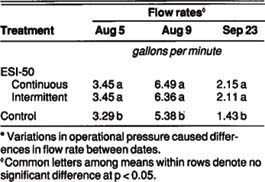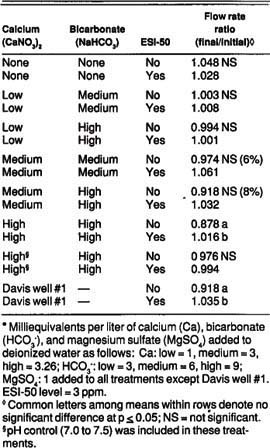All Issues
Clogging of buried drip irrigation systems
Publication Information
California Agriculture 44(1):16-17.
Published January 01, 1990
PDF | Citation | Permissions
Abstract
Lime precipitate clogging of buried drip irrigation systems is difficult to detect and can cause problems where water quality is poor. Injecting a phosphonate was as effective as acid against clogging in two field trials, and may cost less.
Full text
Clogging is one of the most difficult problems facing users of drip irrigation systems. Emitter clogging can seriously interfere with uniform application of irrigation water and system-applied fertilizers. Often, the result is reduced yield and crop quality. Clogging can result from biological growths, physical particulates, or chemical precipitates in the drip system.
Biological growth clogging is most frequently found in drip systems using surface water sources. The standard method of preventing biological growth is a combination of low water pH, chlorine injection, and sand media filtration.
Suspended mineral particles in the water cause physical particulates to clog both ground water and surface-water-supplied drip systems. Filtration, frequently with screen filters, is used to remove the particulates.
Chemical precipitate clogging is most often encountered in drip systems supplied by groundwater. High levels of calcium, magnesium, bicarbonate, and sulfate can result in chemical precipitation, particularly if the irrigation water is highly alkaline. Calcium carbonate or lime is the most common precipitate. Lowering the pH to below neutral (7.0) through acid injection has been the standard method of minimizing lime precipitation. In the past, sulfuric acid was added to lower the pH of the irrigation water, but safety concerns have curtailed its use. Products such as N-pHURIC, which are effective and safer to handle, are more often used today.
Buried drip irrigation systems, in which drip tapes are buried below the ground surface, cause additional problems because clogged orifices cannot be seen. When ground water is used in these systems, clogging of the small orifices by chemical precipitates can be a serious problem.
Two field experiments were conducted to test an alternative to acid injection for dealing with chemical precipitate clogging in buried drip irrigation systems. This alternative treatment entails injecting into the system low concentrations of ESI-50, a phosphonate material. This chemical is used as a scale inhibitor in industrial applications but has not been used in agriculture. ESI-50 has Environmental Protection Agency approval for use in potable water. Phosphonates are not persistent in the environment, particularly in the soil.
We selected two field sites for testing. At the first, we monitored a commercial buried drip irrigation system near Ripon, California, which had a history of clogging. The second site was an experimental field at the University of California, Davis.
A bell pepper field near Ripon was chosen because of its history of drip tape clogging, resulting primarily from the quality of the groundwater used for irrigation. The chemical constituents of Ripon irrigation water (pH 7.7), in milliequivalents per liter (meq/L), are as follows: calcium, 3.1; magnesium, 0.6; sodium, 1.8; bicarbonate, 3.5; and chlorine, 2.0.
The peppers were direct-seeded March 23, 1988, into 30-inch beds treated with herbicide to reduce weed competition. The drip tape (T-Tape) had a wall thickness of 0.014 inch and flow rate of 0.4 gallon per minute per 100 feet of tape at a pressure of 10 psi. The tape was placed at a depth of 4 inches before planting.
There were three treatments at Ripon: (1) continuous injection of ESI-50 for a final irrigation concentration of 4 ppm, (2) intermittent injection of ESI-50 for a final concentration of 4 ppm during the last 2 hours of each irrigation, and (3) an untreated control. Four replicates of each treatment were evaluated. Each plot consisted of two 400-foot drip tape lines.
Our theory was that the critical time of chemical precipitation was after completion of the irrigation. Factors such as the time irrigation water remains in the drip tubing and increased ionic concentration due to water evaporation can influence precipitate formation. We compared the continuous and intermittent treatments to confirm the hypothesis. The intermittent treatment had the advantage of reduced cost of injected material, but the disadvantage of requiring further automation to control injection times.
The grower chose to add an acid product (N-pHURIC) to the irrigation water to reduce the clogging problems experienced in previous years. Acid injection lowered the pH of the irrigation water to nearly 6.5. Other liquid fertilizers were added during the season, as listed, with all field operations conducted across all treatments:
The flow rates between treatments did not differ significantly while N-pHURIC was injected to lower the pH of the irrigation water to approximately 6.5. When the pH returned to its native level of 7.7 and/or calcium nitrate fertilizer was added, significant flow rate differences were noted (table 1). Flow rate was significantly lower in the untreated control than in either ESI-50 injection treatment between August 5 and 9. When injection of N-pHURIC was restarted on August 10, flow rate differences between treatments were eliminated (data not shown). This finding indicates that the probable cause of clogging was calcium carbonate, which was dissolved by the increased acidity.
Flow measurements made at the end of the season (September 23), after acid injection had ceased, indicated that significant clogging recurred in the control treatment. Both ESI-50 injection treatments showed significantly less clogging.
We conducted the field test at UC Davis to evaluate the effectiveness of ESI-50 in reducing precipitate clogging under a variety of water quality conditions. Because calcium carbonate precipitation is one of the most serious precipitate clogging agents, we added different levels of calcium and bicarbonate (table 2) to deionized water to simulate typical California irrigation waters. The pH levels in these treatments ranged from 8.0 to 8.4.
Additional treatments included use of water from a city of Davis well (well No. 1, pH approximately 8.0) and a high-level calcium/high-level bicarbonate treatment with lowered pH through addition of acid.
Each of the water qualities was evaluated with and without addition of ESI-50. A total of 16 treatments were examined; each was replicated four times.
The drip tape (Hardie Bi-Wall Light) with 12-by 60-inch spacing was buried 3 to 4 inches below ground surface. Each test line was 150 feet in length. Design flow rate at 7 psi pressure was 0.4 gallon per minute 100 feet. No crop was grown to eliminate the possibility of clogging due to root intrusion.
A constant pressure of 7 psi in the irrigation system was maintained through use of a constant head tower. Flow meters capable of measuring very small flow differences in individual drip irrigation lines were used.
The experimental procedure consisted of preparing a tank with chemical constituents appropriate to the treatment and pumping that tank, at constant pressure, into the four buried drip irrigation lines corresponding to the treatment. As the treatment was being irrigated, we monitored the flow rate to each of the four drip lines. This procedure was continued for each of the 16 treatments. All the treatments were irrigated in 2 to 3 days; each was irrigated 10 times during the experiment.
Results are presented in table 3 as a ratio of final flow rate to the pretreatment flow rate. The treatments with low levels of calcium (1 meq/L) showed no significant clogging problem. There was no significant difference between the treatments with and without ESI-50.
As the calcium levels increased to the medium level (2 meq/L), clogging characteristics of the ESI-50 and non-ESI-50 treatments were noticeably different. While not significant at the 6% and 8% levels (table 2).
At high calcium levels, the treatments with and without ESI-50 were significantly different. Adding ESI-50 effectively mitigated precipitate clogging problems in this study.
The high calcium/high bicarbonate treatment with acid added (pH approximately 7.2) showed no significant difference between the ESI-50 treatments. This result indicated that acid injection reduced clogging in the absence of ESI-50.
The Davis city well water treatments, which had calcium levels of approximately 2 meq/L, showed significantly different clogging characteristics with and without ESI-50. Again, addition of ESI-50 was effective in reducing clogging problems. The results of the Davis city well water treatment indicate that a “natural” water behaves similarly to the “artificial” waters used in the other treatments of the Davis field trial.
The results from both the Ripon and Davis field studies confirm that acid injection effectively controls lime precipitation clogging. In addition, ESI-50 can successfully prevent carbonate clogging when injected continuously or during the last 2 hours of irrigation. Cost is a major factor favoring the use of ESI-50. ESI-50 and N-pHURIC are difficult to compare because ESI-50 is used only to prevent chemical precipitation. N-pHURIC provides fertilizer nutrients (nitrogen and sulfur) and can enhance the effectiveness of chlorine when used as a biocide.
At the Ripon site, the grower added 78 gallons per acre of N-pHURIC during the season, at a cost of $100 per acre. This rate resulted in 148 pounds of nitrogen and 156 pounds of sulfur applied to the crop at the estimated value of $74 per acre. The resulting anti-clogging cost of N-pHURIC would be $26 per acre. The cost of adding ESI-50 at 4 ppm is competitive with current anti-precipitate clogging chemicals.
If copper sulfate, which is an effective biocide, were injected as well as ESI-50, the combination might provide a cost-effective method of controlling both calcium and magnesium carbonate precipitates as well as biological growths.






